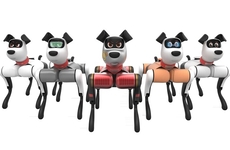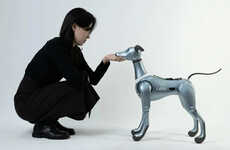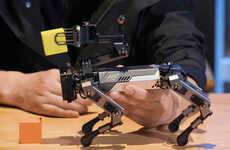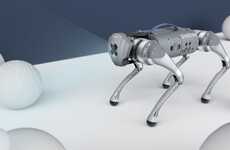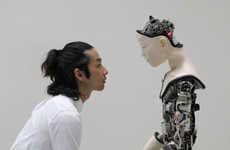
The 'Astro' Robot Easily Traverses Uneven Terrain
Michael Hemsworth — August 16, 2019 — Tech
The 'Astro' robot has been developed as part of a research project at the Florida Atlantic University and aims to bring the power of artificial technology (AI) to canine-inspired robotic solutions.
The robot dog features a 3D-printed head that hides a set of Nvidia Jetson TX2 graphics processing units (GPUs) within that enable the unit to have four teraflops of computing power. Onboard sensors work with a radar imaging module, a bevy of cameras and a microphone to navigate its surroundings, while also taking commands from its human operators.
The 'Astro' robot utilizes a deep neural network in order to learn new tasks via a trial and error process. The research project is led by Associate Professor Elan Barenholtz, Associate Professor William Hahn and Pedram Nimreezi.
Image Credit: Alex Dolce, Florida Atlantic University
The robot dog features a 3D-printed head that hides a set of Nvidia Jetson TX2 graphics processing units (GPUs) within that enable the unit to have four teraflops of computing power. Onboard sensors work with a radar imaging module, a bevy of cameras and a microphone to navigate its surroundings, while also taking commands from its human operators.
The 'Astro' robot utilizes a deep neural network in order to learn new tasks via a trial and error process. The research project is led by Associate Professor Elan Barenholtz, Associate Professor William Hahn and Pedram Nimreezi.
Image Credit: Alex Dolce, Florida Atlantic University
Trend Themes
1. AI-powered Robotics - The development of AI-powered robotic dogs like 'Astro' opens up opportunities for advanced automation and efficient tasks in various industries.
2. Computer Vision - The integration of cameras and sensors in 'Astro' showcases the potential of computer vision technology in creating intelligent robotic systems.
3. Neural Networks - The utilization of deep neural networks in 'Astro' demonstrates the potential for machine learning and adaptive behavior in robotic applications.
Industry Implications
1. Manufacturing - Integrating AI-powered robotic dogs in manufacturing processes can enhance efficiency, reduce costs, and improve safety measures.
2. Security - The use of AI-powered robotic dogs in security services can provide enhanced surveillance capabilities and minimize human risk in dangerous situations.
3. Healthcare - Incorporating AI-powered robotic dogs in healthcare facilities can assist in patient monitoring, therapy support, and improve overall well-being.
4.7
Score
Popularity
Activity
Freshness


